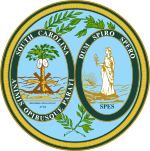| |||||||||||||||||||||||||||||||||||||
All 124 seats in the South Carolina House of Representatives 63 seats needed for a majority | |||||||||||||||||||||||||||||||||||||
|---|---|---|---|---|---|---|---|---|---|---|---|---|---|---|---|---|---|---|---|---|---|---|---|---|---|---|---|---|---|---|---|---|---|---|---|---|---|
| Turnout | 55.03% | ||||||||||||||||||||||||||||||||||||
| |||||||||||||||||||||||||||||||||||||
 Results: Democratic hold Democratic gain Republican hold Republican gain | |||||||||||||||||||||||||||||||||||||
| |||||||||||||||||||||||||||||||||||||
| Elections in South Carolina |
|---|
 |
The 2018 South Carolina House of Representatives elections took place as part of the biennial United States elections. South Carolina voters elected state representatives in all 124 of the state house's districts. State representatives serve two-year terms in the South Carolina State House. A statewide map of South Carolina's state House districts can be obtained from the South Carolina House's website here, and individual district maps can be obtained from the U.S. Census here.
A primary election on June 12, 2018, and a primary runoff on June 26, 2018, in races in which no candidate received over 50% of his/her party's primary vote, determined which candidates appeared on the November 6 general election ballot. Primary election results can be obtained from the South Carolina Secretary of State's website.[1]
Following the 2016 state house elections, Republicans maintained effective control of the House with 80 members. Democrats held 44 seats following the 2016 elections.
In the 2018 election, although multiple seats flipped between parties, there was no net change. Therefore, Republicans maintained an 80-to-44-seat majority over Democrats.
- ^ "Official Results". South Carolina Secretary of State. Retrieved February 22, 2019.

